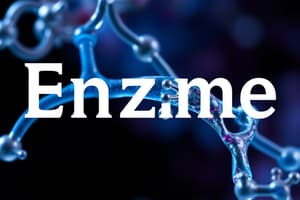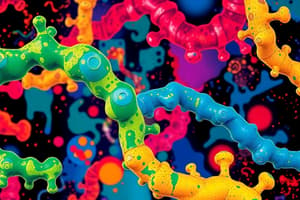Podcast
Questions and Answers
What is the function of an enzyme?
What is the function of an enzyme?
- To prevent reactions from occurring
- To slow down chemical reactions
- To serve as a main energy source
- To speed up chemical reactions (correct)
What is a substrate?
What is a substrate?
A compound or molecule that an enzyme binds to and on which it acts.
What forms when an enzyme binds to its substrate?
What forms when an enzyme binds to its substrate?
Enzyme-substrate complex
What is a product in the context of enzymatic reactions?
What is a product in the context of enzymatic reactions?
What is the active site of an enzyme?
What is the active site of an enzyme?
What is activation energy?
What is activation energy?
What does denaturation refer to?
What does denaturation refer to?
Define a metabolic pathway.
Define a metabolic pathway.
What is an anabolic pathway?
What is an anabolic pathway?
What characterizes a catabolic pathway?
What characterizes a catabolic pathway?
What do endergonic reactions require?
What do endergonic reactions require?
What is ATP?
What is ATP?
What is a catalyst?
What is a catalyst?
What is a biological catalyst?
What is a biological catalyst?
Explain the lock and key hypothesis.
Explain the lock and key hypothesis.
What does the induced fit hypothesis propose?
What does the induced fit hypothesis propose?
Define optimum activity.
Define optimum activity.
What is optimum pH?
What is optimum pH?
What is optimum temperature?
What is optimum temperature?
What is a limiting factor?
What is a limiting factor?
What does thermophilic mean?
What does thermophilic mean?
What are cofactors?
What are cofactors?
Define coenzymes.
Define coenzymes.
What is an apoenzyme?
What is an apoenzyme?
What characterizes a holoenzyme?
What characterizes a holoenzyme?
What is a prosthetic group?
What is a prosthetic group?
Define competitive inhibition.
Define competitive inhibition.
What is non-competitive inhibition?
What is non-competitive inhibition?
What is catalase?
What is catalase?
What is an independent variable?
What is an independent variable?
What is a dependent variable?
What is a dependent variable?
What are intracellular enzymes?
What are intracellular enzymes?
What are extracellular enzymes?
What are extracellular enzymes?
What does specificity mean in the context of enzymes?
What does specificity mean in the context of enzymes?
What does substrate concentration refer to?
What does substrate concentration refer to?
What does enzyme concentration refer to?
What does enzyme concentration refer to?
Flashcards are hidden until you start studying
Study Notes
Enzymes Overview
- Enzymes are proteins that act as catalysts, speeding up chemical reactions by lowering activation energy without being consumed.
- Each enzyme binds to a specific substrate, forming an enzyme-substrate complex during the reaction.
Key Terms
- Substrate: The molecule an enzyme acts upon.
- Product: The substance produced after the chemical reaction.
- Active Site: The portion of the enzyme where the substrate binds and the reaction occurs.
Reaction Dynamics
- Activation Energy: The energy needed to initiate a reaction.
- Denaturation: The process where proteins lose their functional structure due to extreme pH, salt concentration, or temperature changes.
Metabolic Pathways
- Metabolic Pathway: Series of enzymatic reactions that build (anabolic) or break down (catabolic) molecules.
- Anabolic Pathway: Involves constructing larger molecules from smaller units.
- Catabolic Pathway: Involves breaking down larger molecules into smaller components.
Energy and Reactions
- Endergonic Reactions: Require energy input to proceed.
- Exergonic Reactions: Release energy during the process.
Energy Carrier
- ATP (Adenosine Triphosphate): Major energy currency in cells used in many metabolic processes, including enzyme-driven reactions.
Catalyst Functions
- Catalyst: A substance that accelerates a chemical reaction without undergoing permanent chemical change.
- Biological Catalyst: Often refers to enzymes that enhance biological reactions.
Enzyme Action Models
- Lock and Key Hypothesis: Suggests that a substrate fits perfectly into the enzyme's active site.
- Induced Fit Hypothesis: Proposes that the enzyme's active site adjusts to better fit the substrate upon binding.
Optimal Conditions
- Optimum Activity: Ideal conditions for maximum enzyme efficiency.
- Optimum pH: The specific pH level at which an enzyme operates best.
- Optimum Temperature: The best temperature for enzyme activity to maximize reaction rates.
Factors Influencing Enzymatic Activity
- Limiting Factor: A scarce resource that can slow down the rate of reaction.
- Cofactors: Essential molecules (metal ions or organic coenzymes) required for enzyme function.
- Coenzymes: Small organic molecules, often derived from vitamins, that assist enzyme catalysis.
Enzyme Structure
- Apoenzyme: The protein component of an enzyme that needs a cofactor to be active.
- Holoenzyme: The fully active form of an enzyme that contains its cofactor(s).
- Prosthetic Group: A non-protein component that permanently attaches to and is essential for the enzyme's function.
Inhibition Mechanisms
- Competitive Inhibition: Occurs when a substance mimics the substrate's structure and competes for the active site.
- Non-competitive Inhibition: Involves a substance binding to a different location on the enzyme, altering its shape and function.
Types of Enzymes
- Catalase: An enzyme found in living organisms that breaks down hydrogen peroxide into water and oxygen.
- Intracellular Enzymes: Enzymes that function within cells.
- Extracellular Enzymes: Enzymes that act outside their production site, e.g., digestive enzymes.
Reaction Parameters
- Specificity: Refers to the ability of an enzyme to catalyze only one type of reaction.
- Substrate Concentration: The concentration level of substrates available for enzyme reactions.
- Enzyme Concentration: The amount of enzyme present in a solution, affecting reaction rates.
Studying That Suits You
Use AI to generate personalized quizzes and flashcards to suit your learning preferences.




